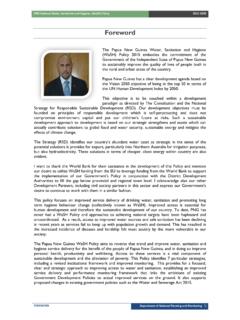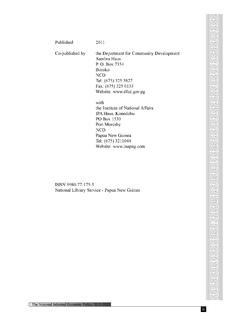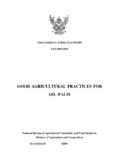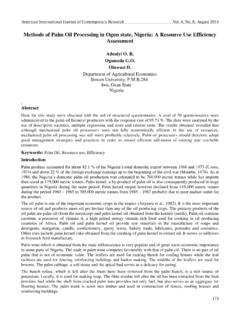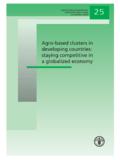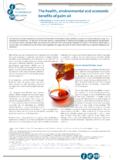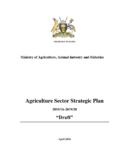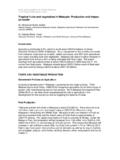Transcription of A Critical Analysis of Agriculture Extension Services in ...
1 A Critical Analysis of Agriculture Extension Services in Papua New Guinea: Past, Present and Future CIMC National Agriculture Conference Theme: Key Drivers for a Robust, Dynamic and Productive Agriculture Sector in PNG 24-25 May 2012 NARI Multi Purpose Hall, Bubia, Lae 2 Table of Contents 1. Introduction .. 3 2. History of Agricultural Extension 4 Pre-Independence Period .. 4 Post-Independence Period .. 5 The decentralization process .. 5 The corporatization of the agricultural sector .. 5 3. Current Status of Agricultural Extension in PNG .. 8 Extension agencies and rural advisory service providers .. 8 Funding of 8 Extension personnel .. 9 Extension 9 Technology transfer .. 9 Human resource development approach .. 11 Private sector assisted delivery .. 12 Participatory or farmer-demand driven 13 4. The Need for Reform in Agriculture Extension and Rural Advisory Services in PNG .. 14 The Challenges to Extension Reform in PNG.
2 14 A New Agricultural Extension Policy .. 18 A National Coalition of Extension and Rural Advisory Service Stakeholders .. 21 Figure 1: Extension and Rural Advisory Service Stakeholders in PNG .. 23 24 Annex 1: Public and Private Extension Agencies in Papua New Guinea .. 26 Annex 2: Estimated Budget Support for Agriculture Extension , 2010 .. 27 Annex 3: Number of Agricultural Extension Personnel in the Public Sector, 2011 .. 28 3 A Critical Analysis of Agricultural Extension Service in Papua New Guinea: Past, Present and Future By Sitapai1 1. Introduction Agricultural Extension is a functional system of applying scientific research results and new knowledge to agricultural practices through farmer education (van den Ban & Hawkins, 1996). The process involves the conscious use of communication of information to help rural peoples form sound opinions and make good decisions on how to improve their production methods and techniques so as to increase farm efficiency and income, and to enhance their levels of livelihoods, and social and education standards.
3 Today, the field of agricultural Extension is more complex and encompasses a wider range of communication and learning activities organized for rural communities by different disciplines, such as agricultural education, agri-business and marketing, agricultural engineering, mass communication, health and environmental sciences. In Papua New Guinea (PNG), the complexity in the agricultural Extension service has evolved with political, administrative, and institutional reforms over the last fifty years (Sitapai, 2011). Commencing as a single line central government function in the 1950s and 1960s, the agricultural Extension service is presently a shared responsibility of the three-tiers of Government as well as statutory commodity boards, semi- or quasi-government organizations. However, despite the institutional complexity of service providers, the Extension service is industry specific and supply-driven, with a primary focus on increasing production of cash crops.
4 The Extension service is also highly dependent on public funding. Hence, with the declining Government budgetary support over the years, the quality of the service has deteriorated, with limiting coverage nation-wide. The state of decline in the quality of agricultural Extension service in PNG has been extensively reviewed over the last twenty years. The Asian Development Bank (ADB) studies in the early 1990s recommended further institutional reforms for research and Extension in PNG (ANZDEC, 1993). Subsequent reviews by the National Department of Agriculture and Livestock (NDAL) in the late 1990s (McKillop, 1994) and early 2000s (GOPNG, 2000) led to a National Extension Summit in 2004 (Dekuku , 2005). This paper presents an account of the evolution of agricultural Extension prior to, and since Independence, including an Analysis of the current status of Extension service providers. It also outlines a process of reform as a way forward in mobilizing the potential of the rural advisory Services , and as an effective tool for achieving agricultural and rural development.
5 The paper concludes that this reform will be best aided by a new and robust Extension policy, promoted by a national advocacy mechanism for Extension stakeholders in PNG. 1 Address: Pacific Agri-Systems Limited, Box 534, Port Moresby, NCD, PNG. Email: Much of the information for this paper was collated in a 2011 study for NARI & the ACP-EU Technical Centre for Agriculture and Rural Cooperation (CTA). 4 2. History of Agricultural Extension Services Pre-Independence Period The agricultural Extension service has a history dating back to the late 1930s with the advent of plantation Agriculture (Dennis, 1981). After the 2nd World War, the early Administration commenced the rehabilitation of the Agriculture sector, under a colonial policy of developing an export-oriented economy based on selected perennial tree crops. As part of this effort, the Administration, through its colonial Department of Agriculture Stock and Fisheries (DASF) commenced a network of agricultural experiment stations in the 1950s, located at strategic position in the country.
6 The research facilities were established in the Central, East New Britain, Morobe, Eastern Highlands and Western Highlands Provinces. The oldest of these establishments was the Lowlands Agricultural Experiment Station at Kerevat, in East New Britain. It was established in 1938, and was rebuilt after the Japanese invasion in 1945. The research centres were the sources of improved stock and plant genetic material, and information for farming communities. DASF also established Extension centres in all districts, which became depositories of improved genetic material from research for distribution, and were also venues for farmer training and information dissemination. The Extension support to farmers was delivered using the Training and Visit (T&V) system. The objective was to identify highly suitable areas of land for plantation crops, and promote the establishment of estate and smallholder plantings using improved genetic material and technical advice.
7 Many agricultural projects in the two decades prior to Independence were driven exclusively by this approach, including the development of land settlement schemes for rubber and cocoa in the mid-1960s, and the oil palm schemes in the early 1970s. Early livestock Extension was limited to cattle production. Commercial cattle grazing were promoted on ranches as well as under plantations crops. The latter was an ideal dual-production system in most coastal areas. Smallholder cattle farming was promoted under a World Bank (WB) subvention in the 1960s and this led to the expansion of pasture areas in Madang and Morobe, central Highlands and the Papuan coasts (McKillop, 1976). Extension officers were trained at agricultural training colleges, established by DASF in the mdi-1960s. The trainee awards were: a certificate in tropical Agriculture after 2 of years training, or a diploma after 3 years of training. The trained officers are generalist in all aspects of Agriculture , and are tasked to visit farmers with prescriptions for their production constraints.
8 An agricultural Extension officer position was a prestigious post in the colonial service, and for many years, this designation constituted a large percentage of civil servants employed by DASF. The impact of agricultural Extension Services prior to Independence was mixed. While there was growth as measured by the planted areas of tree crops and levels of annual agricultural exports to early 1970s, the exclusive focus on the promotion of commercial crops and livestock, meant that the subsistence Agriculture (village livestock and staple food crops), was totally neglected by the Extension service. This situation has continued to the present time. 5 Post-Independence Period The management and delivery of Extension Services in the post-independence period were largely influenced by two government policy interventions: the decentralization policy adopted immediately after Independence, and the corporatization policy of the 1990s. The following is an account of impact of these policies on Agriculture Extension to the present time.
9 The decentralization process The decentralization process was aimed at empowering provinces to determine their own development priorities and manage their expenditure budgets. The policy outcome was the Organic Law on Provincial Governments (OLPG) passed in 1976. OLPG paved the way for the establishment of Provincial Governments, and the transfer of development functions and financial powers from the National Government. A key function decentralized was Agriculture Extension , but is performed as a concurrent function of provincial and national agencies, hitherto. In 1995, OLPG was amended by the Organic Law on Provincial and Local Level Governments (OLPLLG), to give recognition to districts as the focus for local development planning and Services delivery. The Organic Law further decentralized Extension responsibility to local level governments (LLGs). However, at district level, Extension staff report to district managers for their activities, and receive no command from agricultural advisers at provincial headquarters.
10 This situation is made more complex by the administration of district support improvement program (DSIP) grants. Presently, DSIP allows for K1million annually for Agriculture development per district, but it is difficult to ascertain whether this level of expenditure actually occurs, because many district lacked well defined plans and priorities. Generally, the government Extension programs at provincial and district level are poorly staffed and resourced. The situation has not improved despite increases in the provision of provincial grants and rural sector funding over the last decade. Since the late 1990s, several private sector organizations have become directly involved in the provision of Extension and advisory Services . The corporatization of the agricultural sector In 1990, the Government adopted a corporatization policy under which key commodity organizations for coffee, oil palm and cocoa and coconuts were created as separate legal entities.


